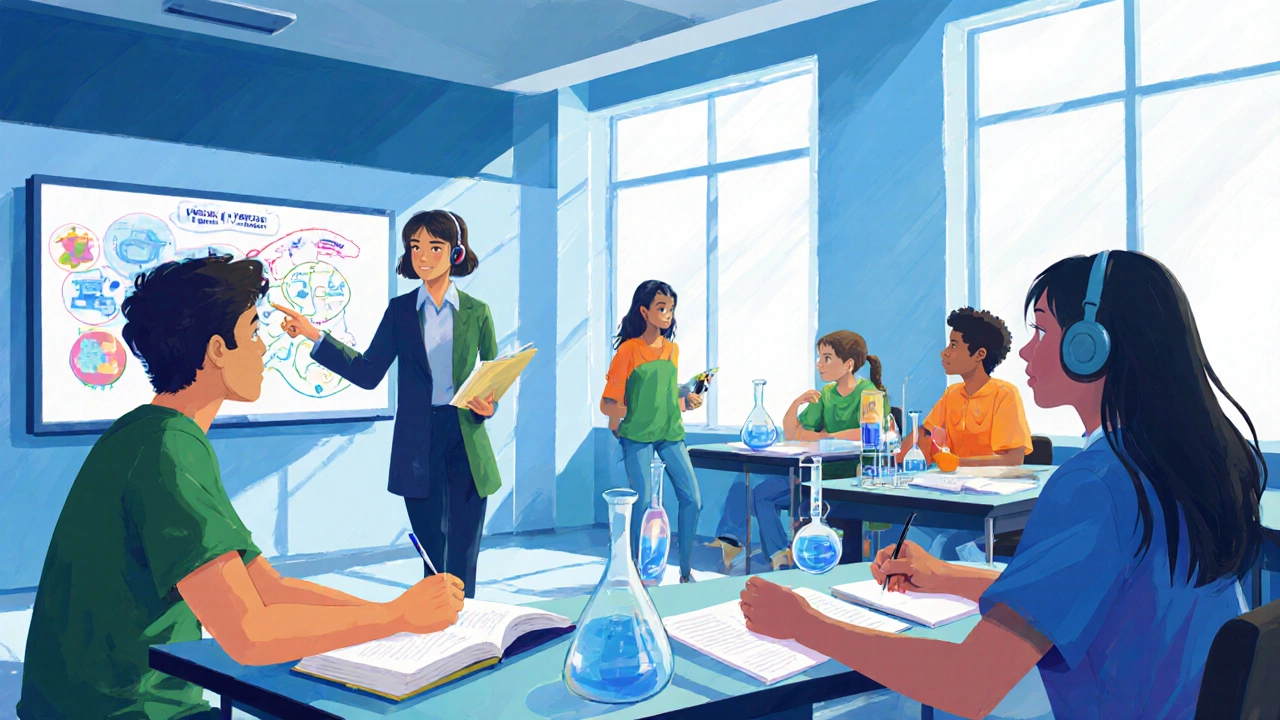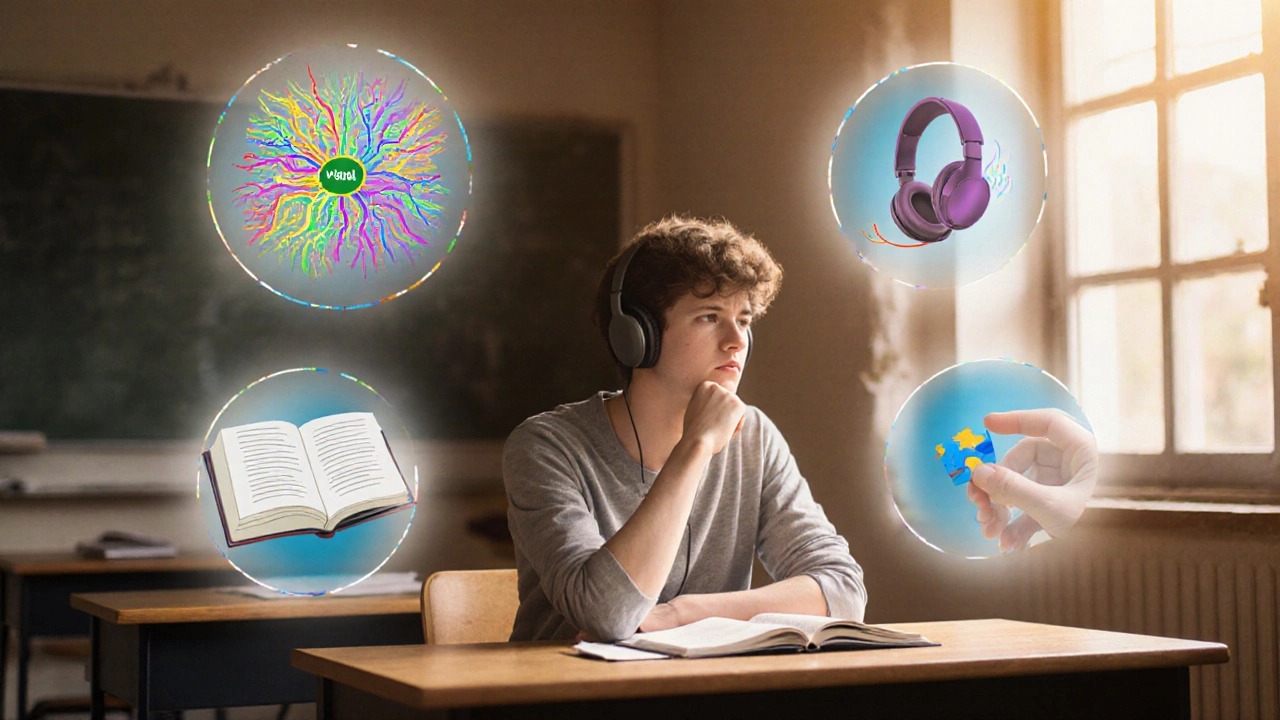Learning Style Effectiveness Checker
Answer the following questions to see how effectively you're applying proven learning strategies:
Key Takeaways
- The idea that one single style works best for everyone is not backed by solid research.
- Studies consistently show that multimodal learning and active engagement outperform single‑modality approaches.
- Understanding your preferences can help you design study sessions, but you should mix visual, auditory, reading/writing, and kinesthetic tactics.
- Tools like the VARK questionnaire are useful for self‑awareness, not for prescription.
- Apply evidence‑based strategies such as spaced repetition, retrieval practice, and dual‑coding to boost retention.
Ever wondered, what is the most powerful learning style? You’ve probably heard friends claim they’re a "visual learner" or a "kinesthetic learner" and wonder if that label can unlock faster grades. The short answer: there isn’t a single champion. The long answer: the most effective approach blends several modes and leans heavily on active processing.
When people talk about a learning style is a preferred way of receiving, processing, and retaining new information, they’re usually trying to find a shortcut for the brain. Over the years, a handful of models have tried to codify those preferences.
Popular Models and Their Building Blocks
The most widely cited framework is the VARK model (Visual, Auditory, Reading/Writing, Kinesthetic). It groups learners into four buckets based on how they like to consume content. For example, a visual learner might gravitate toward charts and colour‑coded notes, while a kinesthetic learner prefers hands‑on activities.
Another classic is Kolb's Experiential Learning Cycle (Concrete Experience, Reflective Observation, Abstract Conceptualisation, Active Experimentation). Kolb argues that effective learning requires moving through all four stages, regardless of your initial preference.
Howard Gardner’s Multiple Intelligences (linguistic, logical‑mathematical, spatial, bodily‑kinesthetic, musical, interpersonal, intrapersonal, naturalist) broadened the conversation further, suggesting that intelligence itself is multi‑faceted. While insightful, this theory is less about study tactics and more about talent identification.

What the Research Actually Says
A handful of meta‑analyses have put the learning‑style myth to the test. A 2023 review of 70 studies involving over 12,000 participants found learning style matching (aligning instruction with a learner’s reported style) produced no statistically significant boost in exam scores.
Conversely, research on active learning (instruction that engages students in doing something beyond listening) shows average gains of 0.6standard deviations - roughly the difference between the 50th and 70th percentile on a typical test.
Studies that compare single‑modality instruction to multimodal learning (using two or more sensory channels simultaneously) consistently report higher retention rates for the multimodal groups. One 2022 experiment with university physics students found that those who studied with a combination of diagrams, narrated videos, and short lab demos scored 15% higher on a later conceptual quiz.
The Myth of the "Best" Single Style
Why does the myth persist? It’s easy to take a quiz, get a label, and feel you’ve unlocked a secret. But the label is a snapshot of preference, not a prescription for success. Cognitive scientists warn that over‑reliance on a single preferred channel can actually limit exposure to richer cues.
Moreover, the brain’s cognitive load theory (the idea that working memory has limited capacity) suggests that mixing modalities can off‑load processing demands. When you read a paragraph while simultaneously viewing an illustration, you distribute the load across visual‑verbal and visual‑spatial subsystems, making it easier to encode the material.
What Turns Out to Be the Most Powerful Approach?
The evidence converges on two ideas:
- Use multiple modes. Pair text with visuals, add short audio explanations, and include a brief activity that forces you to manipulate the concept.
- Make it active. Instead of passively watching a video, pause to summarise, answer a self‑generated question, or sketch the idea.
In practice, that means a "most powerful learning style" looks more like a learning strategy than a fixed trait. For example, a study session could follow the dual‑coding principle: write a definition, draw a related diagram, then explain it out loud. The blend of visual learning (learning through images, charts, and spatial layouts), auditory learning (learning through spoken words and sounds), and kinesthetic learning (learning by doing or moving) captures the benefits of each channel while keeping the brain engaged.

Practical Checklist for Power‑Packed Study Sessions
- Start with a 2‑minute preview: glance at headings, skim a diagram.
- Write a quick summary in your own words (reading/writing).
- Create a visual aid - mind map, sketch, or infographic (visual).
- Record yourself explaining the concept, then replay (auditory).
- Do a short hands‑on activity: solve a problem, build a model, or use a flash‑card app (kinesthetic).
- Space the session: revisit the material after 24hours, then after a week (spaced repetition).
- Test yourself with retrieval practice - no notes, just recall (active learning).
Comparison of Common Learning Styles
| Style | Typical Techniques | Research Support | Best‑Use Scenario |
|---|---|---|---|
| Visual | Diagrams, colour‑coded notes, mind maps | Moderate - helps with spatial memory but not a standalone boost | Complex processes, anatomy, geography |
| Auditory | Lectures, podcasts, reading aloud | Low - benefits fade without active recall | Language learning, musical concepts |
| Reading/Writing | Textbooks, essays, flashcards | High for dense factual info, but best paired with other modes | Legal studies, history dates |
| Kinesthetic | Labs, simulations, role‑play | High for procedural skills | Science experiments, trades, sports tactics |
| Multimodal | Combination of the above | Strong - consistently outperforms single‑mode | Most academic subjects |
| Active Learning | Problem‑solving, peer teaching, retrieval practice | Very strong - yields the largest effect sizes | Exam preparation, conceptual courses |
Frequently Asked Questions
Does matching teaching to my VARK result improve grades?
Large‑scale studies show no measurable improvement when instruction is simply aligned with a learner’s self‑reported VARK preference. The boost comes from using varied methods, not from matching a single style.
Can I be a "pure" visual learner?
Everyone processes information through multiple channels. Even the most visual‑oriented students benefit from reading text and hearing explanations. Relying on one channel limits depth of understanding.
How does cognitive load theory affect study technique selection?
If you overload the verbal channel with dense paragraphs, adding a relevant diagram splits the load, making it easier for working memory to encode. So mixing modalities reduces overload and improves retention.
What are quick ways to make a study session more active?
Try the "Feynman technique": explain the topic aloud as if teaching a child, then identify gaps. Or use a 5‑minute flash‑card drill without looking at notes. Both force retrieval, which solidifies memory.
Should I still take a VARK quiz?
A quiz can be fun for self‑awareness, but treat the result as a hint, not a rule. Use the insight to experiment with different techniques, then keep what actually helps you recall.
Bottom line: the "most powerful learning style" isn’t a static label. It’s a blend of multimodal input and active engagement that taps into how our brains naturally consolidate knowledge. Play with visual, auditory, reading, and kinesthetic tactics, and keep the learning cycle moving. That’s the recipe that consistently shows up at the top of the research ladder.
